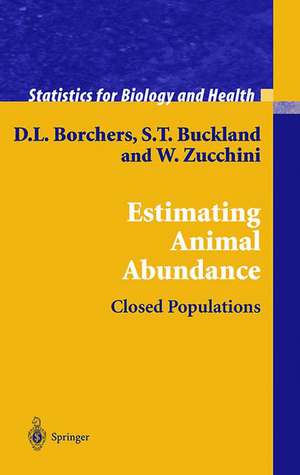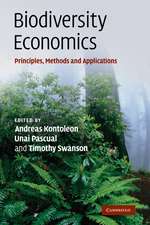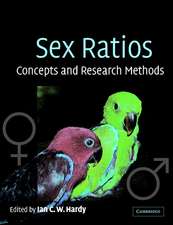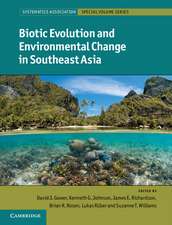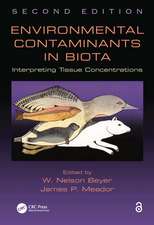Estimating Animal Abundance: Closed Populations: Statistics for Biology and Health
Autor D.L. Borchers, Stephen T. Buckland, Walter Zucchinien Limba Engleză Hardback – iul 2002
| Toate formatele și edițiile | Preț | Express |
|---|---|---|
| Paperback (1) | 390.25 lei 6-8 săpt. | |
| SPRINGER LONDON – 21 oct 2010 | 390.25 lei 6-8 săpt. | |
| Hardback (1) | 397.16 lei 6-8 săpt. | |
| SPRINGER LONDON – iul 2002 | 397.16 lei 6-8 săpt. |
Din seria Statistics for Biology and Health
- 20%
 Preț: 633.24 lei
Preț: 633.24 lei - 17%
 Preț: 352.01 lei
Preț: 352.01 lei - 20%
 Preț: 776.72 lei
Preț: 776.72 lei - 20%
 Preț: 1376.35 lei
Preț: 1376.35 lei - 18%
 Preț: 1394.84 lei
Preț: 1394.84 lei - 18%
 Preț: 883.59 lei
Preț: 883.59 lei - 5%
 Preț: 843.91 lei
Preț: 843.91 lei - 20%
 Preț: 1002.67 lei
Preț: 1002.67 lei - 18%
 Preț: 1395.32 lei
Preț: 1395.32 lei - 5%
 Preț: 1102.10 lei
Preț: 1102.10 lei - 5%
 Preț: 874.83 lei
Preț: 874.83 lei - 15%
 Preț: 657.39 lei
Preț: 657.39 lei - 18%
 Preț: 960.93 lei
Preț: 960.93 lei - 15%
 Preț: 585.90 lei
Preț: 585.90 lei - 5%
 Preț: 852.69 lei
Preț: 852.69 lei - 18%
 Preț: 903.62 lei
Preț: 903.62 lei - 5%
 Preț: 721.40 lei
Preț: 721.40 lei - 15%
 Preț: 653.46 lei
Preț: 653.46 lei - 18%
 Preț: 2114.90 lei
Preț: 2114.90 lei - 18%
 Preț: 1108.99 lei
Preț: 1108.99 lei - 5%
 Preț: 821.39 lei
Preț: 821.39 lei - 5%
 Preț: 849.02 lei
Preț: 849.02 lei - 15%
 Preț: 653.14 lei
Preț: 653.14 lei - 18%
 Preț: 958.56 lei
Preț: 958.56 lei - 5%
 Preț: 722.69 lei
Preț: 722.69 lei - 18%
 Preț: 728.74 lei
Preț: 728.74 lei - 18%
 Preț: 943.22 lei
Preț: 943.22 lei - 5%
 Preț: 1092.43 lei
Preț: 1092.43 lei - 15%
 Preț: 594.21 lei
Preț: 594.21 lei - 5%
 Preț: 377.87 lei
Preț: 377.87 lei - 18%
 Preț: 1124.60 lei
Preț: 1124.60 lei - 18%
 Preț: 1220.12 lei
Preț: 1220.12 lei - 15%
 Preț: 632.98 lei
Preț: 632.98 lei - 18%
 Preț: 1394.84 lei
Preț: 1394.84 lei -
 Preț: 389.11 lei
Preț: 389.11 lei - 18%
 Preț: 959.98 lei
Preț: 959.98 lei
Preț: 397.16 lei
Nou
Puncte Express: 596
Preț estimativ în valută:
75.100€ • 81.27$ • 63.36£
75.100€ • 81.27$ • 63.36£
Carte tipărită la comandă
Livrare economică 18 aprilie-02 mai
Preluare comenzi: 021 569.72.76
Specificații
ISBN-13: 9781852335601
ISBN-10: 1852335602
Pagini: 332
Ilustrații: XIII, 314 p.
Dimensiuni: 155 x 235 x 23 mm
Greutate: 0.63 kg
Ediția:2002
Editura: SPRINGER LONDON
Colecția Springer
Seria Statistics for Biology and Health
Locul publicării:London, United Kingdom
ISBN-10: 1852335602
Pagini: 332
Ilustrații: XIII, 314 p.
Dimensiuni: 155 x 235 x 23 mm
Greutate: 0.63 kg
Ediția:2002
Editura: SPRINGER LONDON
Colecția Springer
Seria Statistics for Biology and Health
Locul publicării:London, United Kingdom
Public țintă
ResearchCuprins
1 Introduction.- 2 Using likelihood for estimation.- 3 Building blocks.- 4 Plot sampling.- 5 Removal, catch-effort and change-in-ratio.- 6 Simple mark-recapture.- 7 Distance sampling.- 8 Nearest neighbour and point-to-nearest-object.- 9 Further building blocks.- 10 Spatial/temporal models with certain detection.- 11 Dealing with heterogeneity.- 12 Integrated models.- 13 Dynamic and open population models.- 14 Which method?.- A Notation and Glossary.- A.1 Notation.- A.2 Glossary.- B Statistical formulation for observation models.- B.1 Detection function.- B.2 Multiple surveys.- C The asymptotic variance of MLEs.- C.1 Estimating the variance of an MLE.- C.2 Estimating the variance of a function of an MLE.- C.3 A one-parameter example.- C.3.1 Fisher information version 1.- C.3.2 Fisher information version 2.- C.3.3 Observed information.- D State models for mark-recapture and removal methods.- D.1 Static population.- D.2 Independent dynamics.- D.3 Markov dynamics.- References.
Recenzii
From the reviews:
"In a unified likelihood-based framework, this book provides an excellent updated introduction to closed population models. The authors also briefly address how the framework can be extended to deal with open populations.....In addition to intended readers in biology, ecology and statistics, this book will reach a wider audience in other disciplines as some closed models have been widely applied to other areas including epidemiology, health sciences, software reliability and census undercount estimation. I compliment the authors for this significant book and hope they will write another on open populations."
Biometrics
"This is a useful book. It provides a comprehensive, readable survey which should be of value to anyone who wants an introduction to the currently available methodology for estimating animal numbers."
International Statistical Institute, Short Book Reviews
"The great strength of this text is that all methods are described not just in the same book, but in the same statistical framework... The authors have gone to great lengths to explain the principles underlying every method, in easily accessible, nonspecialist language. This includes a single-sentence "key idea" at the beginning of every chapter, which is generally a succinct and pertinent introduction. Practitioners with little background in statistics will find these explanations particularly worthwhile, being all too-familiar with the "recipe"approach to statistical analyses...."Coherence for the cognoscenti" is possibly the book's greatest contribution. It unfolds like a well-written sonata, with every section echoing the underlying themes before letting rip with the detailed development. Its potential as a nursery for new research ideas should not be overlooked."
Journal of the American Statistical Association
"This would be a good reference book for bio-statisticians interested in problems of estimation of animal abundance." (T.J. Rao, Sankhya, Vol. 65 (2), 2003)
"This book introduces and surveys the various methods used to assess wildlife populations. … This is a useful book. It provides a comprehensive, readable survey which should be of value to anyone who wants an introduction to the currently available methodology for estimating animal numbers. The book is well-written. … Relevant free software is also available on the web in the form of an R Library of simulation and estimation functions for many of the advanced methods … ." (C.D. Kemp, Short Book Reviews, Vol. 23 (1), 2003)
"This is the first book to provide an accessible, comprehensive introduction to wildlife population assessment methods. It uses a new approach that makes the full range of methods accessible … . This book uses a single conceptual and statistical framework for all the methods. This makes understanding the apparently different methods easier … . As the first truly up-to-date and introductory text in the field, this book should become a standard reference for students and professionals in the fields of statistics, biology and ecology." (T. Postelnicu, Zentralblatt MATH, Vol. 1002 (2), 2003)
"In a unified likelihood-based framework, this book provides an excellent updated introduction to closed population models. The authors also briefly address how the framework can be extended to deal with open populations.....In addition to intended readers in biology, ecology and statistics, this book will reach a wider audience in other disciplines as some closed models have been widely applied to other areas including epidemiology, health sciences, software reliability and census undercount estimation. I compliment the authors for this significant book and hope they will write another on open populations."
Biometrics
"This is a useful book. It provides a comprehensive, readable survey which should be of value to anyone who wants an introduction to the currently available methodology for estimating animal numbers."
International Statistical Institute, Short Book Reviews
"The great strength of this text is that all methods are described not just in the same book, but in the same statistical framework... The authors have gone to great lengths to explain the principles underlying every method, in easily accessible, nonspecialist language. This includes a single-sentence "key idea" at the beginning of every chapter, which is generally a succinct and pertinent introduction. Practitioners with little background in statistics will find these explanations particularly worthwhile, being all too-familiar with the "recipe"approach to statistical analyses...."Coherence for the cognoscenti" is possibly the book's greatest contribution. It unfolds like a well-written sonata, with every section echoing the underlying themes before letting rip with the detailed development. Its potential as a nursery for new research ideas should not be overlooked."
Journal of the American Statistical Association
"This would be a good reference book for bio-statisticians interested in problems of estimation of animal abundance." (T.J. Rao, Sankhya, Vol. 65 (2), 2003)
"This book introduces and surveys the various methods used to assess wildlife populations. … This is a useful book. It provides a comprehensive, readable survey which should be of value to anyone who wants an introduction to the currently available methodology for estimating animal numbers. The book is well-written. … Relevant free software is also available on the web in the form of an R Library of simulation and estimation functions for many of the advanced methods … ." (C.D. Kemp, Short Book Reviews, Vol. 23 (1), 2003)
"This is the first book to provide an accessible, comprehensive introduction to wildlife population assessment methods. It uses a new approach that makes the full range of methods accessible … . This book uses a single conceptual and statistical framework for all the methods. This makes understanding the apparently different methods easier … . As the first truly up-to-date and introductory text in the field, this book should become a standard reference for students and professionals in the fields of statistics, biology and ecology." (T. Postelnicu, Zentralblatt MATH, Vol. 1002 (2), 2003)
Textul de pe ultima copertă
This is the first book to provide an accessible, comprehensive introduction to wildlife population assessment methods. It uses a new approach that makes the full range of methods accessible in a way that has not previously been possible. Traditionally, newcomers to the field have had to face the daunting prospect of grasping new concepts for almost every one of the many methods. In contrast, this book uses a single conceptual (and statistical) framework for all the methods. This makes understanding the apparently different methods easier because each can be seen to be a special case of the general framework. The approach provides a natural bridge between simple methods and recently developed methods. It also links closed population methods quite naturally with open population methods.
The book is accompanied by free software on the web, in the form of an R library, allowing readers to get some "hands-on" experience with the methods and how they perform in different contexts - without the considerable effort and expense required to do this in the real world. It also provides a tool for teaching the methods, including a means for teachers to generate examples and exercises customised to the needs of their students.
As the first truly up-to-date and introductory text in the field, this book should become a standard reference for students and professionals in the fields of statistics, biology and ecology.
The book is accompanied by free software on the web, in the form of an R library, allowing readers to get some "hands-on" experience with the methods and how they perform in different contexts - without the considerable effort and expense required to do this in the real world. It also provides a tool for teaching the methods, including a means for teachers to generate examples and exercises customised to the needs of their students.
As the first truly up-to-date and introductory text in the field, this book should become a standard reference for students and professionals in the fields of statistics, biology and ecology.
Caracteristici
Provides the first accessible introduction to wildlife population assessment methods Adopts a new approach, using a single conceptual (and statistical) framework for all methods Accompanied by free, user-friendly software Includes worked examples and exercises with solutions
